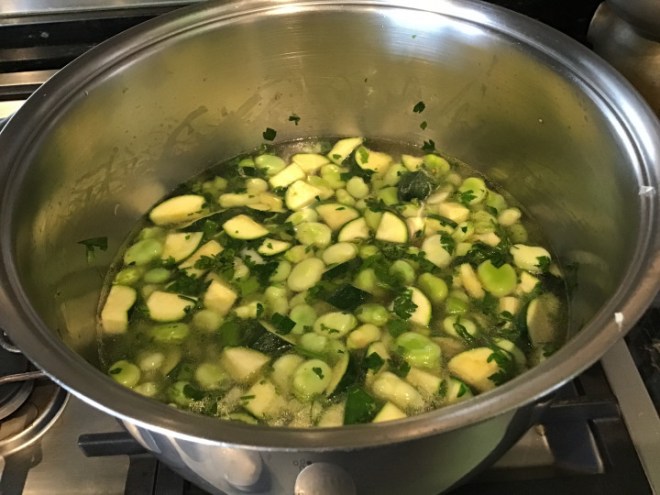

















Pasta e fave (broad beans) is a spring-time, Italian, rustic dish.

There are many Italian, regional combinations of pasta e fave, some add chicory or wild fennel, or tomatoes. Guanciale is an Italian cured meat made from pork’s cheek (guancia – cheek) and it is also a favourite flavouring. Thick bacon can be substituted, but somehow this is not produce I associate with fresh spring flavours and I always omit it. In keeping with the theme of spring, on this occasion I added a couple of zucchini. Fresh mint leaves can be added at the time of serving the pasta.

Peas are also in season in spring and the same dish can be prepared with peas or a combination of broad beans and peas.
Depending on which part of Italy you favour, you can add Pecorino or Parmigiano, but once again, I prefer to keep the taste “clean” and the drizzle of extra virgin olive oil, fresh mint and freshly ground black pepper is enough for me.

Short to medium sized pasta that is suitable for zuppa or minestra (soup) is used in this dish and the pasta can be presented with the broad beans, served either wet or dry. You can choose whether to obtain a rather dry or slightly brothy dish – I always like it wet, just as I like a wet pasta e fagioli (borlotti beans).
I like to cook my pasta in with the beans, however, the pasta can be cooked separately, drained and then added to the beans. If this is your preferred method, cook the broad beans for 20-30 minutes, until soft, cook the pasta until al dente, then drain and dress the pasta with the broad beans and the broth.

1.5 kg fresh broad beans

2 spring onions
1 or 2 fresh garlic cloves
½ cup extra virgin olive oil
salt and to taste pepper to taste
2 zucchini (optional)
chopped parsley
1 litre or more of chicken or vegetable broth (or water)
short pasta, a couple of handfuls or more, depending on how much pasta you prefer
your best and fruitiest, extra virgin olive oil to drizzle on top

Heat extra virgin olive oil and sauté the onions and garlic.
Add the shelled beans, zucchini and parsley and sauté briefly. Add broth, season with salt and pepper, cover, and cook over low heat for about 10 minutes. Make sure that the liquid is boiling before adding the pasta. Add more hot broth or water if needed.


When the pasta is , turn off the heat and serve, but remember to drizzle your best extra virgin olive oil on top….it will be very fragrant!

Add more black pepper and/or fresh mint leaves when serving.
Grated cheese is optional.

Other Recipes with broad beans:
Two Sicilian favourites:
PASTA ALLA FAVORITA (Pasta with artichokes, broad beans, peas alla favorita)
FRITTEDDA (A sauté of spring vegetables)
And for those of you in the Northern hemisphere, a Sicilian specialty:
MACCU (a thick, broad bean soup, made at the end of winter to celebrate spring)
As usual, I look forward to reading Richard Cornish’s regular column Brain Food in The Age on Tuesdays and today he is writing about Kohlrabi (September 7, 2021).
Just as listening to music has the power to bring up memories and reading about Kohlrabi brings up memories of Sicily.
Below are recipes from my blog that use Kohlrabi quite differently to the chefs that Richard mentions in Brain Food including David Moyle, the creative director of Harvest Newrybar near Byron Bay, and Rosalin Virnik from Anchor Restaurant in Melbourne’s Elwood.

Here’s my bit about Kohlrabi and a couple of recipes below.
Cavolo is the generic term for a range of vegetables n the Brassicaceae family. In Italian cavoli are cauliflowers, cavolo verza is a cabbage, there is cavolo nero (Tuscan kale), cavolo rosso (red cabbage).
Just to be perverse, Kohlrabi are called just cavoli in Sicily and in Italian it is cavolo rapa..
Just to confuse things even further, Sicilians call cauliflowers broccoli.

As well as the purple coloured Kohlrabi roots there are light green ones; the root is always sold complete with the leaves and the whole plant is eaten.

One way Kohlrabi is eaten in most of Sicily and Italy is boiled as a vegetable side dish with a dressing of extra virgin olive oil and a squeeze of lemon juice, but the preferred way is to cook it with pasta, as a wet pasta dish.
In Ragusa (Sicily) where my father’s family is from they cook it with homemade pasta called Causunedda.
See recipe and photos:
KOHLRABI with pasta (Causunnedda )
A WET PASTA DISH WITH KOHLRABI
I have also seen Kohlrabi in markets in Vietnam
KOHLRABI and TENERUMI, shared between cultures of Sicily and Vietnam.
Not Sicilian, but a good salad:
KOHLRABI, FENNEL, CELERIAC AND DAIKON MAKE A GOOD SALAD (AND OTHER RECIPES)

In another of Richard Cornish’s regular column Brain Food, he referred to Pasta Con Le Sarde, an iconic dish in Sicilian cooking.
PASTA CON LE SARDE recipes:
PASTA CON LE SARDE, Iconic Sicilian made easy
PASTA CON LE SARDE (Pasta with sardines, from Palermo, made with fennel, pine nuts and currants)
PASTA CON LE SARDE, an iconic Sicilian recipe from Palermo. Cooked at Slow Food Festival Melbourne